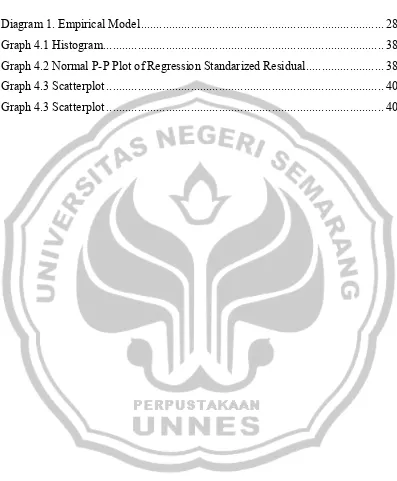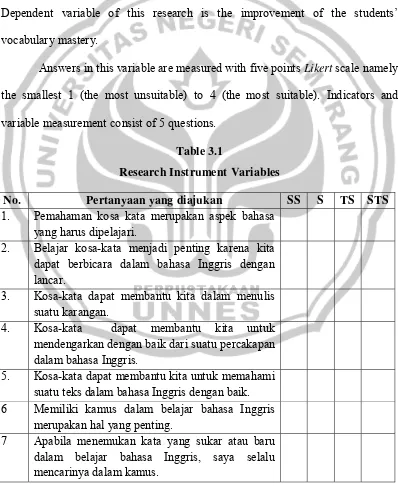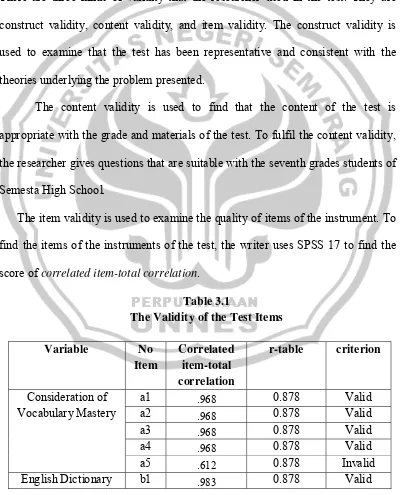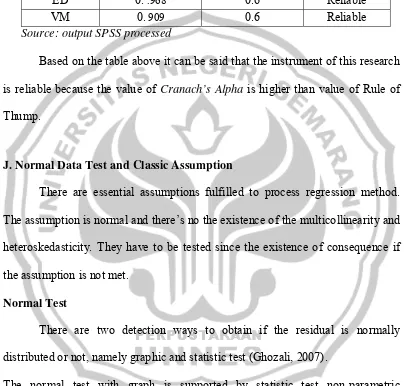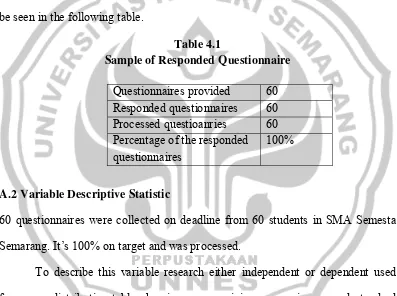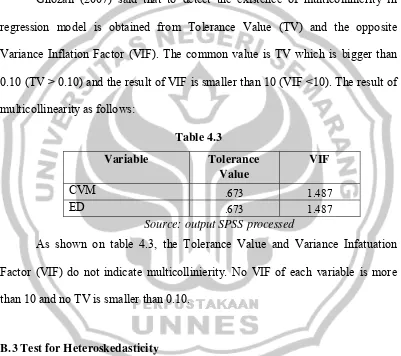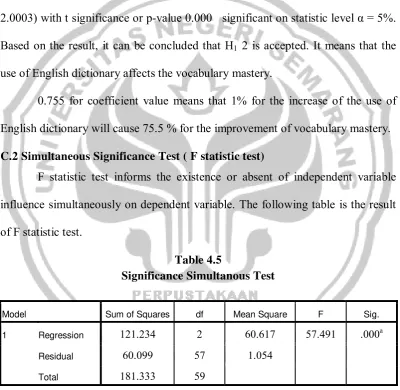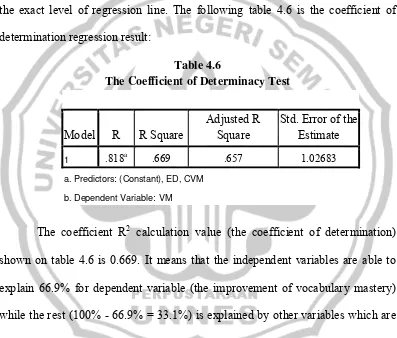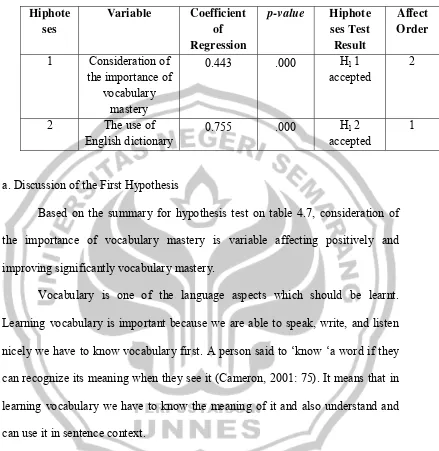THE EFFECTIVENESS OF USING ENGLISH
DICTIONARY TO IMPROVE STUDENTS’
VOCABULARY MASTERY
A Case of Year Eleven Students of Semesta Senior High
School 2009/2010
A final project
submitted in partial fulfillment of the requirements
for the degree of
Sarjana Pendidikan
in English
By Yavuz Yildirim
2201406097
ENGLISH DEPARTMENT
FACULTY OF LANGUAGES AND ARTS
SEMARANG STATE UNIVERSITY
ii
APPROVAL
This final project has been approved by the Board of Examination of English Department of Languages and Arts Faculty of State University of Semarang on 17 Januari 2011.
Board of Examination 1. Chairman
Prof. Dr. Rustono, M.Hum
NIP 195801271983031003 ________________________
2. Secretary
Drs. Ahmad Sofwan, Ph.D
NIP 196204271989011001 ________________________
3. First Examiner
Dr. Dwi Anggani Linggar B., M.Pd.
NIP 195901141989012001 ________________________
4. Second Supervisor as Second Examiner Henrikus Joko Yulianto, S.S, M.Hum.
NIP 196907131999031001 ________________________
5. First Supervisor as Third Examiner Dr. Abdurrachman Faridi, M.Pd.
NIP 195301121990021001 ________________________
Approved by
Dean of Languages and Arts Faculty,
iii
Statement of Work’s Originality
I honestly declare that the final project I wrote does not contain the works or parts of the works of other people except cited in the quotations and the bibliography, as a scientific paper should.
Semarang, May 5, 2010
iv
ACKNOWLEDGEMENTS
It is amazing that finally I can finish my final project despite all difficulties I found during the completing of this project. In this occasion, firstly, I would like to thank Allah S.W.T who never leaves me though sometimes I leave my faith behind.
I would like to express my gratitude to my major sponsor PASIAD for their support during finishing this final project. I also thank to all my lecturers especially. Dr. A. Faridi, M.Pd. as my first advisor and Mr. Henrikus Joko Y, S.S, M.Hum of the English Education Study Program of Semarang State University for the guidance and knowledge they share with me. I also thank library staff and secretariats for allowing me to borrow the books and giving a kind and good service.
My special gratitude goes to my beloved family my mother and my father. I thank them for the love, prayers, and financial support during my study.
My gratefulness also goes to my friends’ cahit, ismail, omer, yahya, asep abi.
My biggest thank to my sister and my lecturers at the English Department. Special thanks go to my big family Semesta High School.
Last but not least, I also thank for those who have given many supports and encouraged me to finish this final project. I am sorry that I cannot write their names personally; there will be a lot.
v
ABSTRACT
Yavuz YILDIRIM. 2010. The Effectiveness of Using English Dictionary to Improve Students’ Vocabulary Mastery. A Case of Year Eleven Students of Semesta Senior High School 2009/2010. A final project. English Department Language and Art Faculty Semarang State University. First Advisor: Dr. A. Faridi, M.Pd, Second Advisor Henrikus Joko Y, S.S, M.Hum
Key Words: a good speaker, consideration for the importance of vocabulary mastery, English dictionary, vocabulary mastery.
One of the skills in English is speaking. To be a good speaker we need a strong vocabulary mutely is model. Ever noticed that people who have a strong English vocabulary receive more attention and respect from their peers, colleagues, subordinates and authority figures. This is because speaking with a strong vocabulary indicates that we take ourselves seriously. The aims of this research are to provide empirical evidence that the consideration for the importance of vocabulary mastery affects significantly the improvement of students’ vocabulary mastery and to provide empirical evidence that the use of English dictionary affects significantly the improvement of students’ vocabulary mastery
In this research, data were taken from 60 eleventh grade students of high school Semesta in the academic year of 2009/2010. To analyze the data, the researcher uses the descriptive quantitative analysis. The quantitative analysis is used to describe whether the use of English dictionary affects significantly the improvement of students’ vocabulary mastery.
vi
CHAPTER II REVIEW OF RELATED LITERATURE A. Effectiveness ... 5
B. The Use of Dictionary ... 6
C. Teaching Vocabulary... 10
D. Vocabulary Mastery ... 15
E. Mastery of Students’ Vocabulary ... 22
F. The Concept of Reading ... 23
CHAPTER III RESEARCH METHOD A. Survey Method ... 26
H. Operational of Empirical Model ... 31
I. Validity and Reliability ... 32
vii
K. Test for Hypotheses... 35
CHAPTER IV RESEARCH FINDINGS AND DISCUSSIONS A. Descriptive Statistic A.1 Sample... 36
A.2 Variable Descriptive Statistic ... 36
B. Normal Data Test and Classical Assumption B.1 Normal Test ... 37
B.2 Test for Multicollinearity ... 39
B.3 Test for Heterokedascity ... 39
C. Test for Hypotheses C.1 Test for Individual Parameter Significance ... 41
C.2 Simultaneous Significance Test ... 42
C.3 The Coefficient of Determination ... 43
D. Discussion ... 43
CHAPTER V CONCLUSION AND SUGGESTION A. Conclusion ... 46
B. Suggestion ... 47
viii
TABLE OF TABLES
Table 3.1 Research Instrument Variables ... 29
Table 3.2 The Validiy of the Test Items ... 32
Table 3.3 The Reliability Test ... 34
Table 4.1 Sample of Responded Questionnaire... 36
Table 4.2 Descriptive Statistics on the Variables ... 36
Table 4.3 The Result of Multicollinearity ... 39
Table 4.4 t Statistics Value for Hypotheses one to four ... 41
Table 4.5 Significances Simultanous Test ... 42
Table 4.6 The Coeficient of Determinacy Test ... 43
ix
TABLE OF DIAGRAMS AND GRAPHICS
Diagram 1. Empirical Model ... 28
Graph 4.1 Histogram ... 38
Graph 4.2 Normal P-P Plot of Regression Standarized Residual ... 38
Graph 4.3 Scatterplot ... 40
1
CHAPTER I
INTRODUCTION
A. Background of the Study
In many branches of knowledge, English books are the main sources, such as Mathematic, Biology, Sociology, Law, Chemistry, Medicine, Engineering, and many others. Lately, English is also spoken in formal and non formal meetings in the world and in Indonesia as well. There are many teaching learning processes conducted in English, especially in the English Department of Universities, English course institutions, discussions, seminars, and so on.
In Indonesian school condition, English is taught from junior high school level until university level. There are also many English course in every town. One of them is an English courses for children or it is usually called English for Young Learners Class. Meanwhile, there are many companies or factories or even state departments that require their employees to master English. They do not demand them to use English passively only, or in a receptive skill, but also to master English actively, that is one who can use English as their means of communication or those who can speak and write English. It means that English is the first and main entrance requirement in communicating between one and another.
students, is not a new subject, since English has been taught since they were in their junior high school level.
Language skills need attention. Nowadays, Indonesia starts to settle long period investment on English education since pre-school. From gradual monitoring done in English language study, unfortunately, there occur some constraints. Therefore, teaching English for High School needs certain method in which the students can easily improve their language skills.
Language and the way we use words conveys intelligence and authority. A person who is a mathematical genius or an expert software developer may be highly respected for technical skills, but if the words that come out of mouth consist of a poor vocabulary, it will, unfortunately, communicate a lack of intelligence.
How do we improve our English vocabulary? One of the best ways to improve our speaking voice is through reading a great deal of material. A strong English vocabulary and communication skills go hand in hand. It is not necessary to speak in ostentatious language and use “50 cent” vocabulary words that will confuse the people we are speaking to.
3
specific vocabulary lists, word formation charts, and visual dictionaries, collocations, and a corpus.
Based on the explanation above, the writer is interested in studying about the effectiveness of using English dictionary to improve vocabulary mastery of eleventh year students.
B. Reason of Choosing the Topic
The main reason of researching about the use of English dictionary at SMA 1 Semesta is that the writer wants to know to what extent the use of English dictionary can improve the students’ vocabulary mastery.
C. Objectives of the Research
These research objectives are;
1. To provide an empirical evidence that the consideration for the importance of using English dictionary.
2. To provide an empirical evidence that the use of English dictionary affects significantly the improvement of students’ vocabulary mastery.
D. Significance of the Study
Theoretically the findings of this study give additional information about the theory to develop English language teaching for teaching vocabulary to senior high school.
Practically the result of this study will be useful for the teacher to find the best strategy of teaching vocabulary and the result of the research could be used by teacher as an input to develop strategy of teaching vocabulary.
This research can encourage the students to improve the English vocabulary. This research can be used as reference to other research a on teaching vocabulary by using dictionary at high school or more advanced students.
E. Presentation of the Study
This final project is composed of five chapters.
Chapter I; is introduction consisting of background of the study, the reason for choosing the topic, the signification of the study and presentation.
Chapter II; is theoretical frame work consisting of teaching vocabulary, the definition of vocabulary mastery, mastery of students’ vocabulary, and the concept of reading.
Chapter III; is research method consisting of subject and object of the research, data collecting method and data analyzing technique.
Chapter IV; is research and discussion consisting.
5
CHAPTER II
REVIEW OF RELATED LITERATURE
In this chapter, the writer presents definition of effectiveness, the use of English dictionary, teaching vocabulary, vocabulary mastery, mastery of students’ vocabulary, and the concept of reading.
A. Effectiveness
According to www.visitask.com, effectiveness is also a measure of the quality of attainment in meeting objectives (Resource effectiveness or team effectiveness); Effectiveness is to be distinguished from efficiency, which is measured by the volume of output achieved for the input used and, hence, is closely related to productivity.
Based on www.qualityresearchinternational.com effectiveness is the extent to which an activity fulfils its intended purpose or function.
Fraser (1994, p. 104) defined it thus:
Effectiveness. This is a measure of the match between stated goals and their achievement. It is always possible to achieve ‘easy’, low-standard goals. In other words, quality in higher education cannot only be a question of achievements ‘outputs’ but must also involve judgements about the goals (part of ‘inputs’)
Erlendsson (2002) defines effectiveness as:
the extent to which objectives are met (‘doing the right things’). The UNESCO definition is
primary measure of success of a programme or of a higher education institution, clear indicators, meaningful information, and evidence best reflecting institutional effectiveness with respect to student learning and academic achievement have to be gathered through various procedures (inspection, observation, site visits, etc.). Engaging in the measurement of educational effectiveness creates a value-added process through quality assurance and accreditation review and contributes to building, within the institution, a culture of evidence. (Vlãsceanu et al., 2004, p. 37)
Wojtczak (2002) defines effectiveness in the context of medical education: Effectiveness: A measure of the extent to which a specific intervention, procedure, regimen, or service, when deployed in the field in routine circumstances, does what it is intended to do for a specified population. In the health field, it is a measure of output from those health services that contribute towards reducing the dimension of a problem or improving an unsatisfactory situation.
B. The Use of Dictionary
Why should we encourage students to use dictionaries? Dictionaries develop learner autonomy. They are a handy resource for researching different meanings, collocations, examples of use and standard pronunciation. If students know how to use them effectively, there are hundreds of hours of self-guided study to be had with a good dictionary. The best way to complement a dictionary investment is strong study skills. As teachers we play an important role in developing those skills, and this article will explore ways that we can do that.
• Different types of dictionary • Monolingual versus bilingual • Learner training
• Conclusion
1) Different types of dictionary:
7
These can be bought cheaply and last a very long time. Students usually complain that big dictionaries are too bulky to bring to class, so I recommend that they have two - a pocket dictionary for class and a 'shelf' dictionary for home study.
• Online dictionaries
Many traditional dictionaries have online editions. Cambridge, for example, has an online advanced learners' dictionary at dictionary.cambridge.org, which is easy to use and provides examples of word use.
• There are some excellent and specialised ones, such as etymonline.com, an etymological dictionary (dictionary that explains the origins of words) I sometimes use in class with higher level learners.
• Urbandictionary.com is a web-based slang dictionary. Like wiktionary.com, users can add content. It is interesting but some of the content is so obscure it is best described as idiosyncratic, not all the definitions are accurate, and many are vulgar (which is part of the point). Their value lies in ease of access to students who own computers, but it is probably also a good idea to direct your learners to traditional ones first.
• Electronic dictionaries
2) Monolingual versus bilingual
Some teachers are opposed to bilingual dictionaries on principle. They believe that learners should think in English as much as possible. I believe that learners should have a bilingual dictionary on hand as a supportive tool but that training should focus on monolingual dictionary work. This is because sometimes a quick translation works best, as in the case of many concrete nouns, but it is a good idea to foster thinking and explanation in English. Bilingual dictionaries can also enable students to express something they want to say when they don't know the correct words in the target language.
3) Learner training
Here are some ideas on how learners to be better at using dictionaries.
• Before beginning, it is very important not to assume that learners, especially at low levels, know how to use a dictionary. Here is a basic task that introduces them to the layout.
• Layout activity
this activity raises awareness of dictionary layout and parts of speech.
• Present learners with a table of words relating to a text you've read in class, for example:
Verb (v.) Adjective (adj.) Noun (n.) surprise surprised surprise
Party x party
... ... celebration
... happy ...
... ... present
9
• Give a brief explanation of the difference between the three parts of speech shown in the table and the symbols, v., adj. and n. used to denote them. Also explain why there is an 'X' in the verb section of 'party'.
• Learners then use their dictionaries to complete the table.
• As a follow up activity, learners look back at the text and discuss why the particular parts of speech were used in that context. This activity underlines the importance of contextualising new vocabulary and integrating it with dictionary work.
4) Dictionary race
This activity makes learning fun and integrates dictionary work with the main aims of the lesson.
• Write down a list of eight words that the class will need for the lesson ahead and their definitions. Jumble them up and give them out to the class. • In groups of four, learners have to look up two words each in their
dictionaries and match them to the definitions on the handout. • They then run to the front to check their answers with the teacher.
• The first group to have a complete set of correct definitions is the winner. 5) Focus on phonology
• Teacher selects some key words that are important for the course / lesson and writes them on the board.
• Learners look up the pronunciation in their dictionaries.
• Teacher pronounces each of the key words in two ways: one is correct and the other is incorrect. Learners use the phonemic spelling to guess which one is right. They get a point for each correct answer.
• In the feedback stage, the teacher drills correct pronunciation and answers any questions.
Teachers should not neglect dictionary work. Like pronunciation, it is a natural part of any course that needs to have an appropriate focus and allocation of time.
By encouraging the intelligent and self-guided use of dictionaries, learners become more independent, and as teachers this is one of our core goals. (www.teachingenglish.org.uk)
C. Teaching Vocabulary
11
exposure to words and intentionally through explicit instruction in specific words and word-learning strategies. According to Michael Graves (2000), there are four components of an effective vocabulary program:
1. wide or extensive independent reading to expand word knowledge
2. instruction in specific words to enhance comprehension of texts containing those words
3. instruction in independent word-learning strategies, and
4. word consciousness and word-play activities to motivate and enhance learning
a) Components of vocabulary instruction
The National Reading Panel (2000) concluded that there is no single research-based method for teaching vocabulary. From its analysis, the panel recommended using a variety of direct and indirect methods of vocabulary instruction.
b) Intentional vocabulary teaching 1) Specific Word Instruction
• Selecting Words to Teach • Rich and Robust Instruction
2) Word-Learning Strategies
According to the National Reading Panel (2000), explicit instruction of vocabulary is highly effective. To develop vocabulary intentionally, students should be explicitly taught both specific words and word-learning strategies. To deepen students' knowledge of word meanings, specific word instruction should be robust (Beck et al., 2002). Seeing vocabulary in rich contexts provided by authentic texts, rather than in isolated vocabulary drills, produces robust vocabulary learning (National Reading Panel, 2000). Such instruction often does not begin with a definition, for the ability to give a definition is often the result of knowing what the word means. Rich and robust vocabulary instruction goes beyond definitional knowledge; it gets students actively engaged in using and thinking about word meanings and in creating relationships among words.
Research shows that there are more words to be learned than can be directly taught in even the most ambitious program of vocabulary instruction. Explicit instruction in word-learning strategies gives students tools for independently determining the meanings of unfamiliar words that have not been explicitly introduced in class. Since students encounter so many unfamiliar words in their reading, any help provided by such strategies can be useful.
13
the meaning of an unfamiliar word by scrutinizing the text surrounding it. Instruction in contextual analysis generally involves teaching students to employ both generic and specific types of context clues.
b) Fostering word consciousness
A more general way to help students develop vocabulary is by fostering word consciousness, an awareness of an interest in words. Word consciousness is not an isolated component of vocabulary instruction; it needs to be taken into account each and every day (Scott and Nagy, 2004). It can be developed at all times and in several ways: through encouraging adept diction, through word play, and through research on word origins or histories. According to Graves (2000), "If we can get students interested in playing with words and language, then we are at least halfway to the goal of creating the sort of word-conscious students who will make words a lifetime interest."
c) Multiple exposures in multiple contexts
students with opportunities to encounter words repeatedly and in more than one context.
d) Restructuring of vocabulary tasks
1) Findings of the National Reading Panel
• Intentional instruction of vocabulary items is required for specific texts. • Repetition and multiple exposures to vocabulary items are important. • Learning in rich contexts is valuable for vocabulary learning. Vocabulary
tasks should be restructured as necessary.
• Vocabulary learning should entail active engagement in learning tasks. • Computer technology can be used effectively to help teach vocabulary. • Vocabulary can be acquired through incidental learning. How vocabulary
is assessed and evaluated can have differential effects on instruction. • Dependence on a single vocabulary instructional method will not result in
optimal learning.
15
Panel, 2000). According to Kamil (2004), "once students know what is expected of them in a vocabulary task, they often learn rapidly."
e) Incidental vocabulary learning
The scientific research on vocabulary instruction reveals that most vocabulary is acquired incidentally through indirect exposure to words. Students can acquire vocabulary incidentally by engaging in rich oral-language experiences at home and at school, listening to books read aloud to them, and reading widely on their own. Reading volume is very important in terms of long-term vocabulary development (Cunningham and Stanovich, 1998). Kamil and Hiebert (2005) reason that extensive reading gives students repeated or multiple exposures to words and is also one of the means by which students see vocabulary in rich contexts. Cunningham (2005) recommends providing structured read-aloud and discussion sessions and extending independent reading experiences outside school hours to encourage vocabulary growth in students.
D. Vocabulary Mastery
According to Red John (2000: 16) vocabulary is knowledge involves knowing the meanings of words and therefore the purpose of a vocabulary test in to find out whether the learners can match each word with a synonym, a dictionary – tape definition, or an equivalent word in their own language.
In learning vocabulary automatically we have to know the meaning of words itself and can use it in sentences. Wilkins (1972: 130) states that vocabulary learning is learning to discriminate progressing the meaning of words in the target language from the meanings of their nearest ‘equivalent’ in the mother tongue. It is also learning to make the most appropriate lexical choices for particular linguistic and situational context.
a) Kinds of Vocabulary
Surely, there are some words in a sentence and those collections of words include to the vocabulary because vocabulary is a list or collections of words arranged in alphabetical order and explained. Those words could be Noun which is usually used as subject or object, Verb or it is usually used as predicate in a sentence, Adverbs etc.
The sentence may be further divided according to the functions of each word has in the subject – predicate relationship – each of these functions is classified as a different part of speech. They are:
1. Noun
17
Example:
a. It is a magazine
b. There is an umbrella
2. Verb
It is the word which expresses an action or a help to make a statement. Example:
a. Mr. Herman is teaching mathematic. b. The students are playing football 3. Adjective
It is the word used to qualify noun or pronoun. Example:
a. Mr. Herman is clever
b. This magazine is expensive
5. Adverb
It is a word used for qualifying the meaning of verb, adjective, or another adverb.
Example:
a. Mrs. Nurul is teaching in the classroom. b. I go to campus at nine o’clock
6. Conjunction
It is a word used to relate one word to another one, or one sentence to another one.
a. I have to call him before I go. b. Irma and I are student at untirta. 7. Pronoun
It is the word which can take the place of a noun. Example:
a. They are my lecture. b. He goes to office. 8. Interjection
It is a word put into a sentence to express a sudden feeling of mind or emotion.
Example:
a. Hurrah! I am the winner.
b. Oh my god, I can’t believe it’s real. (Frank, 1972: 1)
b) Material of vocabulary
In learning vocabulary, there are some materials that relate with vocabulary like word family, word classes, synonyms, antonyms that can help learners in comprehending vocabulary deeper.
1. Word Family
19
1.1 Prefix
Prefix is a syllable added at the beginning of words to change their meaning. The words of prefixes are , in-, dis-, mis-, re-, pre-, etc. the prefix un-and in-, are the most common negative prefix which both mean not. Prefix mis-, means wrong, pre-, means before, re-, means again, etc. the example words of prefixes are:
Words Added prefix Meaning
Popular Unpopular not popular
Active Inactive not active
Consistent Inconsistent not consistent
Writing Prewriting before writing
Build Rebuild build again
For example in sentence:
He is not popular artist (without Prefix) He is unpopular artist. (Adding by Prefix Un-)
1.2 Suffix
Suffix is syllable added at the end of words to change their meaning or their part of speech. The words of suffix are -ment, -ion, -ness, -less, -er/-or, -ist, etc. the suffix –ment, -er /-or, and –ist are changed verb form becomes noun. The example is act (Verb) added suffix or becomes actor (Noun), etc. while the stuffiness is used to change adjective form becomes noun. The example is weak (Adj) added suffix ness becomes weakness (Noun). While the suffix less means without. The example words of suffix are:
Word Added suffix
Art artist
Direct director
Use useless
Kind kindness
Agree agreement
For example in sentence:
They plays football in the yard. (As a Verb) They are a good football player. (As a Noun)
21
2. Synonyms and Antonyms
Learning Vocabulary, it means that we learn about meaning. Many words in English sometimes have more than one meaning. So there are many words although different but has similar meaning called synonyms. Beside similar, sometimes we must know the opposite meaning of the word called antonym. To appropriate in using synonyms we must consider with the context.
2.1Synonyms
Synonyms are words that share a similar meaning. For example, old, ancient, antique, elderly are all synonyms in that they share the common meaning of not young /new. However, there the similarity ends. Synonyms are similar, but seldom the same. Even between words that seem interchangeable, such as taxi and cab or aubergine and eggplant, one will be preferred over the other in certain context and by particular speakers.
For example:
Words Synonyms
Look See
Use Wear
Good Excellent
For example in sentence:
Andi uses bicycle to go to school. He is wearing blue t-shirt.
used to describe for everything in general, while for wear is used to describe for something that will be used in the body.
2.2Antonym
Antonyms are words with the opposite meaning. For example like old and new. It is called antonym, because the antonym of old is new. Like synonyms, the relation between such opposite is not always black and white (to use two antonyms) and the very notion of oppositeness is troublesome. The opposite of an old woman is a young woman, but opposite of an old record is a new record not a young record. So, it can be assumed that both synonyms and antonyms have useful defining function and it depends on the context.
For example:
Words Antonyms
Man woman
Old New
Young New
The example in sentence:
1. Mr. Yayan karyana is a young man 2. He is an old man.
The example in sentence:
23
From the examples, we can compare between first example and second example. Although both of the sentences use old word but the antonym is different. For the first example, the antonym of old is young because it describes age. While for the second example, the opposite meaning of old is new because it describes the condition of car. So, the writer can assumes that when we will use both antonym and synonym, it must be appropriate with the context in a sentence or text.
E. Mastery of Students’ Vocabulary
In learning vocabulary, people will experience development each year appropriate with their age. According to Richard (1989: 177) for native speakers of language, they continue to expand their vocabulary in adulthood. In social role and mode of discourse taking place in adulthood, in vocabulary there is continued development beyond the childhood years with adults constantly adding new words to their vocabulary through reading, occupation, and other activities. The primary period for conceptual development, however, is early childhood.
average person speaking on a telephone makes use of a vocabulary of only some 2.000 words (Mackey, 1965).
Meanwhile, for Indonesian learners who learn English as one of foreign language that is taught in school, they have limited words or vocabulary that they now or understand of the language. So, they experience low development in expanding the vocabularies.
F. The Concept of Reading
Reading is one of the information skills in English, we can get actual news, up-date information that happens and worth knowledge by reading. Reading books, newspaper, magazine, and literary works in English can help learners to increase their mastery in vocabulary.
According to Wddowson (in Alderson and Urquhart, 1985: 5) reading is the process of getting linguistics information via print. Harirs and Sipay (1997: 7) state that reading is mainly concerned with learning to recognize the printed symbols, which present speech, and to respond intellectually and emotionally as he would if the material were spoken rather than printed.
From the expert above, the writer can assumes that reading is process to get information, knowledge from literary that is written by someone and is printed out via print and it is a process to recognized the printed symbols to the reader.
a) Technique of Reading
25
1. Scanning
Scanning is technique used to look for specific information. Scanning is not fast reading but rather a process or technique of reading. In reading at a normal speed, readers concentrate on horizontal distance between pauses, but when they scan they also use the vertical extent. In scanning, the reader lets his eyes low down the page, maybe following a set pattern, may be reading around word that catches his eyes. The exact technique scanning depends on the purpose. Scanning is used to locate specific information, for example in encyclopedia or an index. It also can be used to review an article just read in order to mentally fix the important information, to discover the general organization or framework of the article, or to preview an article.
2. Skimming
Skimming is used to quickly identify the main idea of the text. Skimming is done at a speed three to four times faster than normal reading. People often skim when they have lots material to read in a limited amount of time.
26
CHAPTER III
RESEARCH METHOD
In this chapter, the writer discusses the research method
.
This part consists of survey method, objective of the study, hypotheses, research variable, data source, data test, data analyze, operational of empirical model, validity and reliability, normal data test, and test for hypotheses.The research method used in this study is descriptive method, presenting a picture of types of people or of social activities. The descriptive method is a study to collect information related with status of existing indication that is indication according to the real situation during the study. The descriptive study does not examine a certain hypothesis but only to describe a real variable, indication or situation (Arikunto, 1998).
The goal of this method is to describe an on going condition, besides this method is to answer questions of problem in a research (Umar, 1998). Survey, case study, content analysis, etc are included in descriptive methods. The descriptive method used in this study is survey.
A. Survey Method
27
and a friend, survey is for tangible data, direct observable; and intangible data, indirect observable.
The survey method of this study observes the students Semesta High School in their vocabulary learning. The data are score of the students in learning vocabulary. Then the data are used to describe the effectiveness of using English dictionary to improve the students’ vocabulary for year Eleventh Students of Semesta High School Year 2009/2010.
B. Objective of the Study
This research stresses on the use of English dictionary. It will take 25 eleventh grade students of Semesta High School Semarang.
This research aims are (1) to provide an empirical evidence that the consideration for the importance of vocabulary mastery affects significantly the improvement of students’ vocabulary mastery (2) to provide an empirical evidence that the use of English dictionary affects significantly the improvement of students’ vocabulary mastery.
C. Hypotheses
This research is going to answer the focused research, namely: Is the eleventh grade students’ vocabulary in Semesta High School Semarang good enough?
Then, leading the following hypotheses:
Ho : The eleventh grade students’ vocabulary is good enough H1 : The eleventh grade students’ vocabulary is not good enough
Based on the operational observation, the hypotheses’ can be developed to the following hypotheses’:
Ho1 : The consideration for the importance of vocabulary mastery does not affect the improvement of students’ vocabulary mastery
H1 1 : The consideration for the importance of vocabulary mastery affects the improvement of students’ vocabulary mastery
Ho 2 : The use of English dictionary does not affect the improvement of students’ vocabulary mastery
H1 2 : The use of English dictionary affects the improvement of students’ vocabulary mastery
Diagram 1 Empirical Model
The consideration for the importance of vocabulary mastery
The use of English dictionary
29
D. Research Variable
Independent variable is variable which the exist can influence dependent variable. Based on the research hypotheses, vocabulary mastery and articles supporting are compiled as independent variable, namely (1) the consideration for the importance of vocabulary mastery, (2) the use of English dictionary.
Dependent variable is variable which exists influenced by other variables. Dependent variable of this research is the improvement of the students’ vocabulary mastery.
Answers in this variable are measured with five points Likert scale namely the smallest 1 (the most unsuitable) to 4 (the most suitable). Indicators and variable measurement consist of 5 questions.
Table 3.1
Research Instrument Variables
No. Pertanyaan yang diajukan SS S TS STS
1. Pemahaman kosa kata merupakan aspek bahasa yang harus dipelajari.
2. Belajar kosa-kata menjadi penting karena kita dapat berbicara dalam bahasa Inggris dengan lancar.
3. Kosa-kata dapat membantu kita dalam menulis suatu karangan.
4. Kosa-kata dapat membantu kita untuk mendengarkan dengan baik dari suatu percakapan dalam bahasa Inggris.
5. Kosa-kata dapat membantu kita untuk memahami suatu teks dalam bahasa Inggris dengan baik. 6 Memiliki kamus dalam belajar bahasa Inggris
merupakan hal yang penting.
8 Bagi saya merupakan hal yang mudah untuk menemukan kosa-kata yang sukar dalam kamus. 9 Kosa-kata yang saya cari dari kamus selalu sesuai
dengan maksud dalam teks yang saya baca.
10 Kamus membantu saya dalam pengucapan kata bahasa Inggris dengan benar.
11 Kamus dapat digunakan dalam meningkatkan kosa-kata.
12 Kamus dapat digunakan untuk meningkatkan pronunciation (cara pengucapan kata).
13 Kamus dapat mempermudah pemahaman kosa-kata dalam wacana.
14 Kamus dapat membantu belajar bahasa Inggris menjadi menyenangkan.
15 Kamus dapat meningkatkan/memperlancar pembelajaran bahasa Inggris.
E. Data Source
Data source in this research is a primary and secondary. A primary data are obtained from respondents. The data is questionnaire answers provided to obtain information needed in this period. While required secondary data are regulations and rules, researches and literature. A secondary data is collected from sources.
Field research will be done by giving questionnaire related with vocabulary mastery.
F. Data Test
31
pilot test with sample (n) 5 before using it. Validity and reliability test are analyzed for each variable.
G. Data Analyze
Analysis data used in this research is multivariate analysis method. Multivariate analysis generally associates with statistic methods all together analysis for more than two variables on each object or person (Santoso, 2002).
To observe the effect of the whole independent variables for dependent variable, the analysis instrument taken in this multivariate analysis used multiple regression model. This research used SPSS (Statistical Package for the Social Sciences) for windows version 17 to get the result on regression model and statistic test.
H. Operational of Empirical Model
The preceding empirical model can be operated in the form of regression as follows:
Y1 = b0 +b1 X1 + b2 X2 + ei
Where:
Y1 : The improvement of the students’ vocabulary mastery (VM) bo : Constant
b1-2 : Individual parameters holding for the independent variables X1 : The consideration for the importance of vocabulary mastery (CM) X2 : The use of English dictionary (ED)
I. Validity and Reliability Validity
Validity is important when arranging the research instrument in order that the test is acceptable and can be used for the research instrument. According to Arikunto (2005: 65), a test is valid if it measures what is purpose to measure. There are three kinds of validity that the researcher used in the test. They are construct validity, content validity, and item validity. The construct validity is used to examine that the test has been representative and consistent with the theories underlying the problem presented.
The content validity is used to find that the content of the test is appropriate with the grade and materials of the test. To fulfil the content validity, the researcher gives questions that are suitable with the seventh grades students of Semesta High School.
The item validity is used to examine the quality of items of the instrument. To find the items of the instruments of the test, the writer uses SPSS 17 to find the score of correlated item-total correlation.
Table 3.1
The Validity of the Test Items
Variable No
33
b2 .612 0.878 Invalid
b3 .983 0.878 Valid
b4 .983 0.878 Valid
b5 .983 0.878 Valid
Vocabulary Mastery c1 .167 0.878 Invalid
c2 .955 0.878 Valid
c3 .955 0.878 Valid
c4 .955 0.878 Valid
c5 .955 0.878 Valid
Based on the table above, there are 3 invalid items among 15 items test, they are a5 (Consideration of English Dictionary), b2 (English Dictionary) and c1 (Vocabulary Mastery). Those invalid items are not used in calculating the result of this research.
Reliability
Reliability means the consistent and stable indications of the characteristic being investigated. Harris (1969: 14), states that a test does not measure anything well unless it measures consistently. Meanwhile, Arikunto (1998: 170) states that reliability shows that an instrument can be believed enough to be used as instrument to collect the data. Researcher instrument is said to be reliable when it produce constant result after testing. Heaton (1997: 155) describes some factors affecting the reliability of the test are:
1. The extent of the sample of materials selected for testing. 2. The administration of the test.
3. Personal factors such as motivation.
The reliability test of this study uses Cronbach Alpha technique.
Table 3.2 The Reliability Test
Variable Cranach’s Alpha Rule of Thump Criterion
CVM 0. .957 0.6 Reliable
ED 0. .968 0.6 Reliable
VM 0. 909 0.6 Reliable
Source: output SPSS processed
Based on the table above it can be said that the instrument of this research is reliable because the value of Cranach’s Alpha is higher than value of Rule of Thump.
J. Normal Data Test and Classic Assumption
There are essential assumptions fulfilled to process regression method. The assumption is normal and there’s no the existence of the multicollinearity and heteroskedasticity. They have to be tested since the existence of consequence if the assumption is not met.
Normal Test
There are two detection ways to obtain if the residual is normally distributed or not, namely graphic and statistic test (Ghozali, 2007).
35
Test for Heteroskedasticity
This research used graphic plot to test Heteroskedasticity, by checking the exist of certain design shown on scatter plot. The problem of Heteroskedasticity will exist when graphic plot arrange a certain design (to wave, to expand then to narrow), and Heteroskedasticity will not exist when there’s no certain design on graphic plot and drops scatter above and below of zero on Y axis.
K. Test for Hypotheses
This research used multiple regression statistic tests, it would see the influence of independent variable on dependent variable.
a. Individual Parameter Significance Test (t statistic test). It shows how far the influence one independent variable in explaining dependent variable variation. The test used significance common level, a = 5%.
b. Simultaneous Significance (F statistic Test). It shows if all independent variables inserted the model influence simultaneously for dependent variable. c. The coefficient of Determination (R2). It measures goodness in fit from
36
CHAPTER IV
RESEARCH FINDINGS AND DISCUSSION
A. Descriptive Statistic A.1 Sample
The number of the eleventh grade students of SMA Semesta Semarang in the academic year 2009/2010 is 60. The writer takes all of them as the population of the research. All questionnaires are responded well and can be analyzed. It can be seen in the following table.
Table 4.1
Sample of Responded Questionnaire
Questionnaires provided 60 Responded questionnaires 60 Processed questioanries 60 Percentage of the responded questionnaires
100%
A.2 Variable Descriptive Statistic
60 questionnaires were collected on deadline from 60 students in SMA Semesta Semarang. It’s 100% on target and was processed.
To describe this variable research either independent or dependent used frequency distribution table showing mean, minimum, maximum, and standard deviation. Analysis based on respondents’ answers described as follows:
Table 4.2
Descriptive Statistics on the Variables
Variable N Minimum Maximum Mean Standard Deviation
CVM 60 9.00 16.00 12.2167 1.59546
ED 60 11.00 16.00 13.2500 1.20205
37
Interpretation:
N shows number of valid data so potential to be processed. Mean is all scores on data divided with numbers of data. Standard deviation is a deviation measurement, the small result makes the data close to mean. The high standard deviation shows the worse spreading data. When Standard deviation is bigger than mean (SD>M), it indicates the exist once of outlier. Mean of consideration vocabulary mastery and English dictionary shown on table 4.2 are bigger than standard deviation, it means that the variables affect the vocabulary mastery.
B. Normal Data Test and Classic Assumption
There are essential assumptions fulfilled to process regression method. The assumption is normal and there’s no the existence of the multicollinearity, autocorality, and heteroskedasticity. They have to be tested since the existence of consequence if the assumption is not met.
B.1 Normal Test
Graph 4.1
39
As shown on graph, histogram is normally distributed. Normal plot graph shows that drops scatter around diagonal and follow the diagonal line so it means normal distributed. Then, this regression model meets normal assumption.
B.2 Test for Multicollinearity
Ghozali (2007) said that to detect the existence of multicollinierity in regression model is obtained from Tolerance Value (TV) and the opposite Variance Inflation Factor (VIF). The common value is TV which is bigger than 0.10 (TV > 0.10) and the result of VIF is smaller than 10 (VIF <10). The result of multicollinearity as follows:
Table 4.3
Variable Tolerance Value
VIF
CVM .673 1.487
ED .673 1.487
Source: output SPSS processed
As shown on table 4.3, the Tolerance Value and Variance Infatuation Factor (VIF) do not indicate multicollinierity. No VIF of each variable is more than 10 and no TV is smaller than 0.10.
B.3 Test for Heteroskedasticity
Graph 4.3
The drops of scatter plots scatter random either above or below 0 on Y axis. It means that there’s no heteroskedasticity on regression model.
C. Test for Hypotheses
This research used multiple regression statistic tests, it would see the influence of independent variable on dependent variable.
a. Individual Parameter Significance Test (t statistic test). It shows how far the influence one independent variable in explaining dependent variable variation. The test used significance common level, a = 5%.
b. Simultaneous Significance (F statistic Test). It shows if all independent variables inserted the model influence simultaneously for dependent variable.
41
variable explained by independent variable. The regression coefficient value is in between 0 and 1.
C.1 Test for Individual Parameter Significance (t statistic test)
To test hypotheses one to four, t significance value or p-value is used to conclude if there’s an influence of each independent variables on dependent variable or not. t statistic value for hypotheses one to four as follows:
Table 4.4
1 (Constant) -2.741 1.496 -1.832 .072
CVM .443 .102 .403 4.331 .000
ED .755 .136 .518 5.566 .000
a. Dependent Variable: VM
Based on the above table, the regression model as follows: VM = 2.741 + 0.443CVM + 0.755 VM
a.1 Test for the First Hypotheses
H1 1 : Consideration of the importance of vocabulary mastery affects the vocabulary mastery
0.443 for coefficient value means that 1% for the consideration of the importance of vocabulary mastery increase will cause 44.3 % for the improvement of vocabulary mastery.
a.2 Test for the Second Hypotheses
H1 2: English dictionary affects the improvement of vocabulary mastery. Shown on table 4.4, t calculation is also bigger than t table (5.566> 2.0003) with t significance or p-value 0.000 significant on statistic level α = 5%. Based on the result, it can be concluded that H1 2 is accepted. It means that the use of English dictionary affects the vocabulary mastery.
0.755 for coefficient value means that 1% for the increase of the use of English dictionary will cause 75.5 % for the improvement of vocabulary mastery.
C.2 Simultaneous Significance Test ( F statistic test)
F statistic test informs the existence or absent of independent variable influence simultaneously on dependent variable. The following table is the result of F statistic test.
Table 4.5
Significance Simultanous Test
Model Sum of Squares df Mean Square F Sig.
1 Regression 121.234 2 60.617 57.491 .000a
Residual 60.099 57 1.054
Total 181.333 59
a. Predictors: (Constant), ED, CVM
b. Dependent Variable: VM
43
(0.05). Then, it can be concluded that H1 is accepted. It means that independent variables (consideration of the importance of vocabulary mastery, the use of English dictionary,) affect simultaneously for the improvement of vocabulary mastery.
C.3 The Coefficient of Determination (R2)
The coefficient of determination value or coefficient R2 (R square) shows the exact level of regression line. The following table 4.6 is the coefficient of determination regression result:
Table 4.6
The Coefficient of Determinacy Test
Model R R Square
a. Predictors: (Constant), ED, CVM
b. Dependent Variable: VM
The coefficient R2 calculation value (the coefficient of determination) shown on table 4.6 is 0.669. It means that the independent variables are able to explain 66.9% for dependent variable (the improvement of vocabulary mastery) while the rest (100% - 66.9% = 33.1%) is explained by other variables which are not included in regression model of the research.
D. Discussion
Table 4.7
Summary for Hiphoteses Test
Hiphote
1 Consideration of
the importance of
a. Discussion of the First Hypothesis
Based on the summary for hypothesis test on table 4.7, consideration of the importance of vocabulary mastery is variable affecting positively and improving significantly vocabulary mastery.
Vocabulary is one of the language aspects which should be learnt. Learning vocabulary is important because we are able to speak, write, and listen nicely we have to know vocabulary first. A person said to ‘know ‘a word if they can recognize its meaning when they see it (Cameron, 2001: 75). It means that in learning vocabulary we have to know the meaning of it and also understand and can use it in sentence context.
45
When they get a lot of vocabulary, it makes them easier to understand text well, to listen, to write, and to speak. Fluently in English.
Therefore, it can be concluded that the consideration of the importance of vocabulary mastery will affect significantly in improving vocabulary mastery. b. Discussion of the Second hypothesis
Based on the summary for hypothesis test on table 4.7, the use of English dictionary is variable affecting positively and improving significantly vocabulary mastery. It effects bigger in improving students’ vocabulary mastery, 75.5%, than the consideration of the importance of vocabulary mastery, 44.3%.
Dictionaries develop learner autonomy. They are a handy resource for researching different meanings, collocations, examples of use and standard pronunciation. If students know how to use them effectively, there are hundreds of hours of self-guided study to be had with a good dictionary.
The students think that having English dictionary is very important to learn English. It help them to find out difficult words and to pronounce words well. They do not get difficulty in finding out new or difficult words from the text in dictionary. Then they can understand the text well and pronounce the words well.
46
CHAPTER V
CONCLUSION AND SUGGESTION
A. Conclusion
From the research that has been done about the effectiveness of using English dictionary to improve vocabulary mastery of eleventh year students in SMA Semesta Semarang, the researcher can draw some conclusions:
Based on the hypotheses test result, consideration of the importance of vocabulary mastery and the use of English dictionary variables affect positively and significantly for the improvement of vocabulary mastery. This test for regression model shows that consideration of the importance of vocabulary mastery and the use of English dictionary are able to explain 66.9% for variability or development which exist in the improvement of vocabulary mastery, while 33.1% is explained by other factors out of the model such as the English teachers, facilities provided by schools, English textbooks, curriculum, school expectation, and others.
When students get a lot of vocabulary, it makes them easier to understand text well, to listen, to write, and to speak fluently in English. It can be concluded that the consideration of the importance of vocabulary mastery will affect significantly in improving vocabulary mastery.
47
words from the text in dictionary. Then they can understand the text well and pronounce the words well. Finally, the writer concludes that the use of English dictionary will affect significantly in improving vocabulary mastery.
B. Suggestion
Based on the conclusion, the writer would like to propose some suggestions which would be useful for the teacher, the students and for other researchers.
For teachers, the English teachers should encourage their students to use English dictionary because it effects positively and significantly for the improvement of vocabulary mastery.
For students, the students should consider the importance of vocabulary mastery since it helps them to improve their vocabulary mastery.
48
BIBLIOGRAPHY
Arikunto, Suharsimi. 1998. Prosedur Penelitian SuatuPendekatan Praktek. Jakarta: RinekaCipta.
Beck,
2002,
Creating Robust Vocabulary: Frequently Asked Questions And Extended Examples, The Guilford PressCameron, 2001, Teaching Languages To Young Learners, Cambridge University press
Faser, 1976, Practical Faster Reading: A Course in Reading and Vocabulary for Upper- Intermediate and More Advanced Students, Cambridge
University Press
Ghozali, Imam, 2007, AplikasiAnalisisMultivariatdenganProgram SPSS, edisi 3, BadanPenerbituniversitasDiponegoro, Semarang.
Graves, M.F., 2000, Vocabulary learning and instruction
.
In E.Z. Rothkopf (Ed.), Review of Research in EducationHarris, David P. 1969. English Testing as a SecondLanguage. New York: mc Graw hill.
Harris, L. A and Smith, C. B. 1972.Reading Instruction through Diagnostic Teaching.New York: Charles Scribner’ Son.
Heaton, J.B. 1957. Writing English Language Test. London: Longman Group Ltd. Nagy, 2004, Learning words from context. Reading Research Quarterly
Richards, Jack C. 1984. Error Analysis, Perspectives on Second language acquisition.Golborne: Longman Group Ltd.
Stanovich, K.E, 1998, Matthew Effects in Reading: Some consequences of individual Differences in the acquisition of literacy. Reading Research Quarterly
Stahl, 1999, Vocabulary Development, Brookline books
Santoso, 2008, Metodologi Penelitian Kuantitatif untuk Psikologi dan Pendididikan,
Yogyakarta, Pustaka Pelajar
49
Internet Sources:
www.wisegeek.com/what-are-some-good-ways-to-improve-my-vocabulary.htm -
www.exforsys.com/career-center/english-vocabulary.html
Wilkins,1972, Linguistics in Language Teaching, University College, London.
